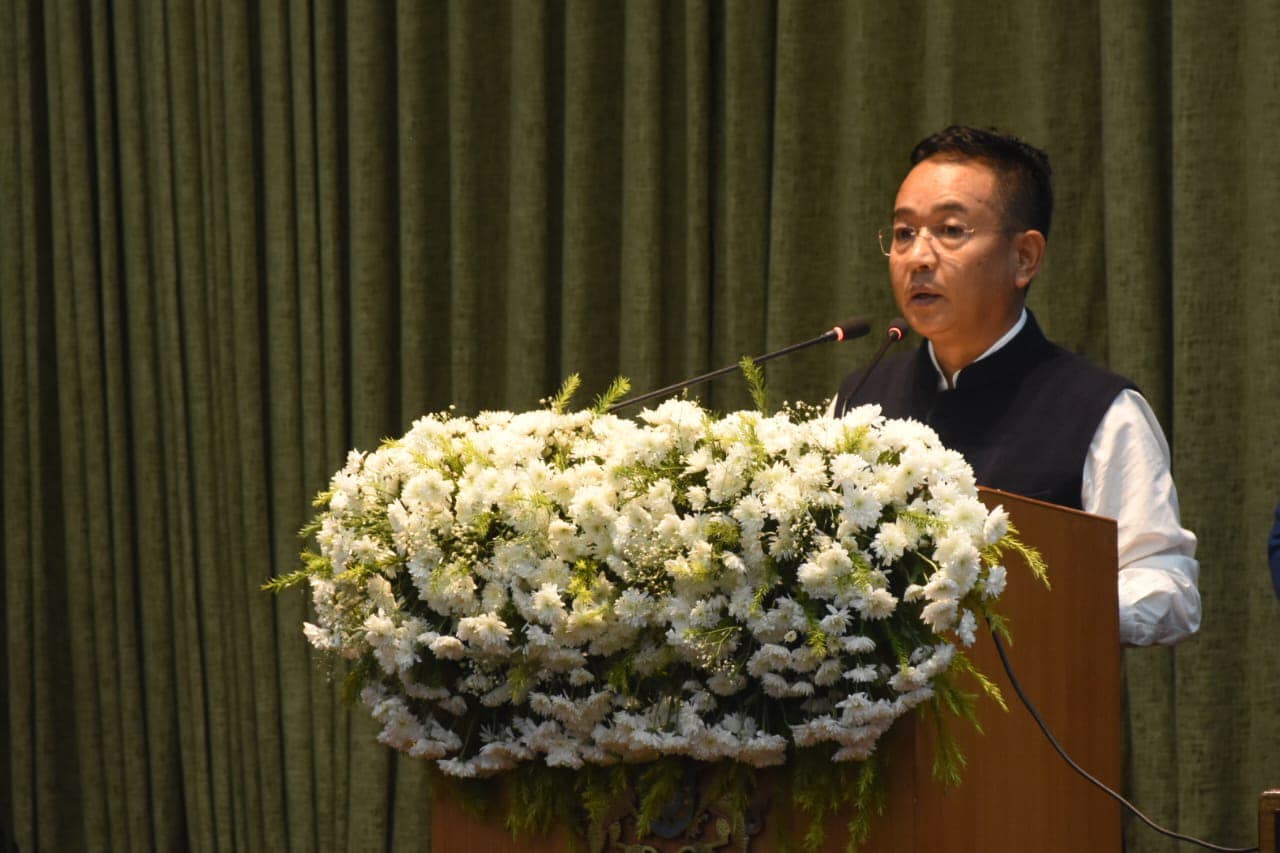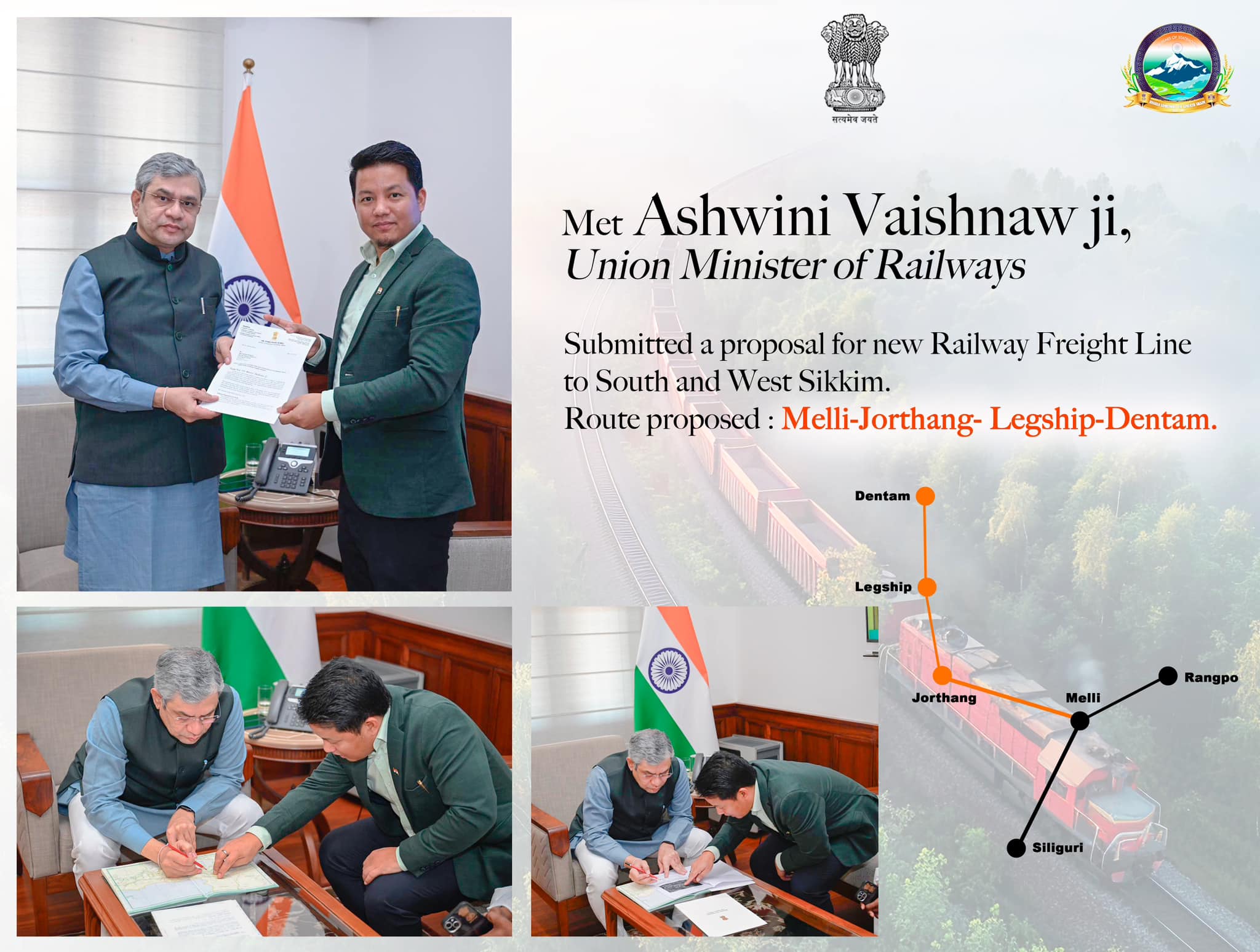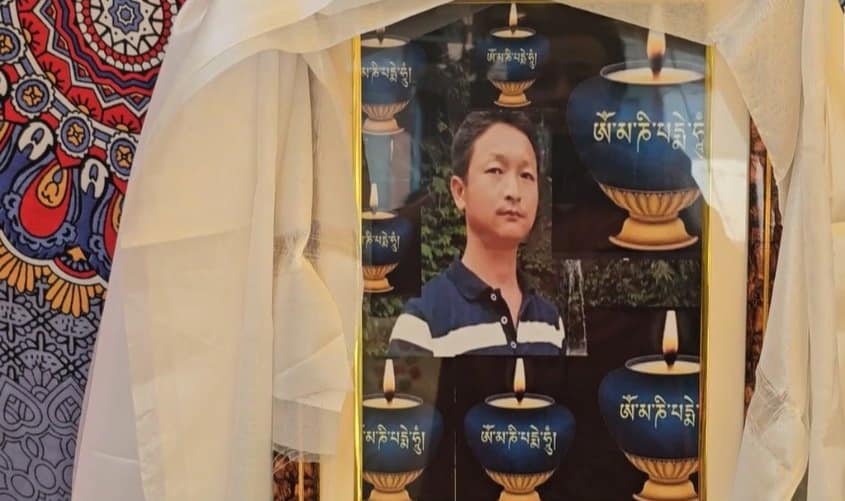
Gangtok, October 4 (IPR): The Chief Minister Mr Prem Singh Tamang-Golay has announced a significant initiative for the welfare of lumberjacks working under the Forest and Environment Department, while addressing the inherent risks and challenges associated with their work.
This announcement was made during the State Disaster Risk Reduction Day programme, organised by the Sikkim State Disaster Management Authority (SSDMA) under Land Revenue and Disaster Management Department (LR&DMD), at Chintan Bhawan in Gangtok, today.
The Chief Minister has urged the concerned department to expedite the necessary procedures to implement the insurance scheme for lumberjacks at the earliest. Additionally, he also assured that similar insurance facilities would soon be extended to all other workers engaged in high-risk professions across the state.
The Chief Minister who is also the Chairman of SSDMA was addressing the event as chief guest. He was accompanied by Mr Sonam Lama, Minister for Public Health Engineering, Water Resources and Ecclesiastical Departments, Mr Arun Upreti, Minister for Rural Development and Cooperation Departments, Mr Samdup Lepcha, Minister for Social Welfare, Women and Child Development and Printing & Stationery Departments, and Ms Namrata Thapa, Relief Commissioner cum Secretary, LR&DMD, along with special guests, Mr SA Rizvi, Advisor (Mitigation), National Disaster Management Authority (NDMA) and Professor VK Sharma, Vice Chairman, SSDMA on the dais.
Addressing the gathering, the Chief Minister stressed the importance of collaboration and community participation in disaster resilience efforts, stressing that disaster preparedness and mitigation measures can only succeed with strong public support. He noted that despite ongoing efforts to mitigate natural disasters, many citizens still neglect house insurance, leaving them vulnerable to financial losses during disasters. He urged everyone to prioritise insuring their homes and properties.
The Chief Minister also highlighted the importance of following government guidelines when building houses. He cautioned against violating approved blueprints, emphasising that homes designed for three storeys should not be discreetly extended to five storeys without proper authorization. He emphasised that safety measures must be adhered to, particularly for houses near riverbanks and in other vulnerable areas.
He acknowledged that while natural disasters are inevitable, given Sikkim’s unique geographical vulnerability to natural calamities, the risks can be mitigated, and the resulting damage can be significantly reduced by taking proactive measures to reduce vulnerabilities and prevent avoidable destruction. He thereby called for strict adherence to building regulations. He pointed out that illegal settlements and construction in sinking areas exacerbate disaster risks and must be avoided.
While commending the dedication and efforts of the government departments, organisations and agencies involved in the recent Glacial Lake Outburst Floods (GLOF) expedition conducted in Sikkim, the Chief Minister highlighted such expeditions and studies as crucial for understanding the risks faced by the state and developing effective responses. He stated that once the study reports are submitted to the state government, official notifications will be issued, which must be strictly followed by all.
He paid tribute to those who had lost their lives due to disasters over the last decade, urging everyone to remember their sacrifice and use it as a motivation to improve safety and preparedness for future generations.
The Chief Minister reiterated that development is impossible without people’s support, and appealed to the public to build infrastructure as per government safety guidelines to prevent future disasters. He further urged citizens to stay alert to disaster risks and support the government in its disaster risk reduction initiatives and contribute to making Sikkim a safer state.
At the onset, the event commenced with the observance of a solemn one-minute silence in memory of those who lost their lives in various natural disasters over the last decade.
In her keynote address, Ms Namrata Thapa, Relief Commissioner cum Secretary, LR&DMD, emphasised the state’s ongoing efforts toward disaster preparedness and resilience-building. She reflected on the importance of State Disaster Risk Reduction Day as a platform for collaboration, allowing stakeholders to come together to forge stronger systems that protect the people of Sikkim from the increasing threats of natural disasters, particularly in the context of global warming and climate change.
She highlighted the increasing risk of Glacial Lake Outburst Floods (GLOF) as one of the state’s most pressing concerns. She expressed deep gratitude to the Chief Minister for his unwavering support and leadership, which have been pivotal in advancing Sikkim’s disaster risk reduction programmes and strengthening the state’s resilience against environmental risks. She reaffirmed that the Government of Sikkim has always been at the forefront of addressing environmental tragedies through proactive measures.
She also underscored the cultural and environmental significance of Sikkim’s lakes, describing them as both natural resources and sacred elements embedded in the state’s heritage. While stressing the need to preserve their sanctity, she noted that these lakes could pose flood risks due to the effects of climate change. She further addressed the growing frequency of landslides and other natural disasters, highlighting the necessity of robust disaster management plans.
Reflecting on the October 3-4, 2023 flood, Ms Thapa called it a stark reminder of nature’s power and the urgent need to safeguard lives and livelihoods. She assured that the state government remains committed to mitigating the risks posed by GLOF and other climate-related threats through collaborative efforts across various departments.
She then outlined the recent multidisciplinary efforts led by the LR&DMD, which, on August 31, 2024, conducted a hazard assessment of six high-risk lakes in the upper reaches of Mangan district. This assessment involved five state government departments namely Science & Technology, Mines & Geology, Land Revenue, Water Resources and Forest & Environment Departments, central agencies such as the Geological Survey of India and the Central Water Commission, as well as Sikkim University. Support from the Indian Army, ITBP, and local bodies such as Lachung Dzumsa and Lachen Dzumsa was instrumental in the success of this mission. Earlier, in June 2024, a similar survey was conducted in Gyalshing district. The data from these assessments will play a critical role in flood modelling and risk assessment, with reports to be submitted to the state government, she stated.
She further highlighted the department’s ongoing community outreach programmes, workshops, and training sessions to educate people about GLOF risks and preparedness. These initiatives aim to build local capacity, ensuring that communities are both aware of the risks and equipped to respond swiftly when needed.
Ms Thapa further presented several key suggestions, including student engagement to foster disaster awareness from a young age, hospital preparedness to ensure swift medical responses during emergencies, and the readiness of government departments to act efficiently in times of crisis. She also stressed the importance of involving local governance bodies, ensuring the convergence of state and central programmes, and strengthening civil defence mechanisms, among others.
Mr Dhiren Shrestha, Principal Director, Science & Technology Department, Government of Sikkim, delivered a comprehensive presentation on the recent study of GLOF in Sikkim and the initiatives of the Government of Sikkim in addressing glacial threats in the state.
Furthering the discourse on disaster management, a presentation on GLOF risk reduction initiatives was delivered by Mr Deepak KC from UNDP, Nepal joining the event virtually.
One of the event’s highlights was the felicitation of the multidisciplinary team members who participated in the recent GLOF Expedition from August 31 to September 14, 2024 in recognition of their critical contributions, alongside central government agencies, the Indian Army, ITBP, local governance bodies and QRTs who were also felicitated for their noteworthy support during the expedition.
On the occasion, the official logo and poster for ‘Sikkim Mission Himtaal – Saamarth Sikkim, Surakshit Sikkim’ were launched. A new mobile application on disaster management called ‘Sikkim Apada Sampark Sewa’ was also launched.
The event also featured video presentations showcasing the various activities of SSDMA and the recent GLOF Expedition 2024.
The event also included a moving obituary for the Late Mr Namgyal Wangdi, Civil Defence Warden, honouring his contributions and dedication to public safety.
Eminent experts, including Professor VK Sharma, Vice Chairman, SSDMA, and Mr SA Rizvi, Advisor (Mitigation), NDMA addressed the gathering, sharing their expertise on disaster management and mitigation strategies while stressing the need for continued vigilance and community involvement in disaster risk reduction.
The event concluded with a vote of thanks by Mr HK Chettri, Special Secretary, LR&DMD.
Earlier, the welcome address was delivered by Mr Prabhakar Rai, Director, SSDMA.
The programme was attended by Cabinet Ministers, MLAs, Advisors, GMC Mayor, Deputy Mayor, Principal Secretaries, Senior Police Officers, DCs, heads of various departments, ADCs, SDMs, BDOs, DPOs, dignitaries from central agencies, apadan mitras, civil defence volunteers and representatives of NGOs.
Report from DIO-Gangtok






